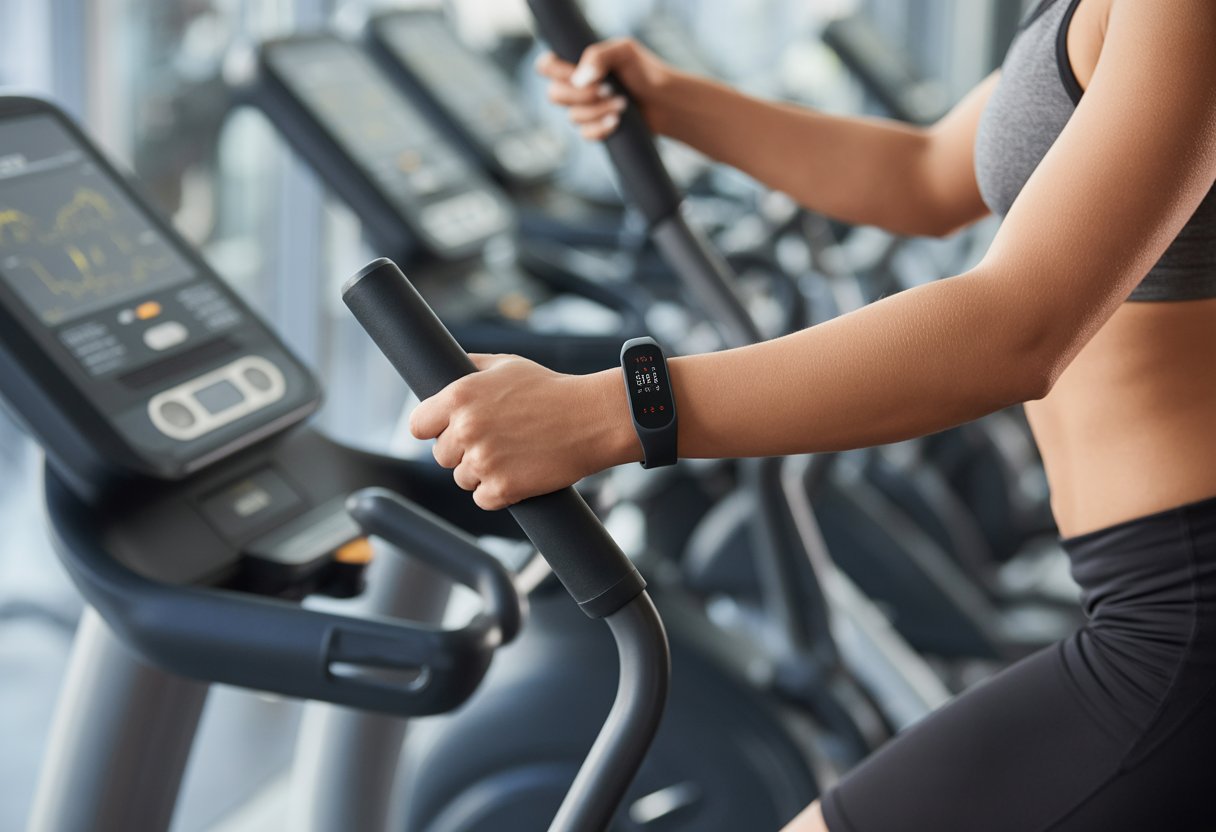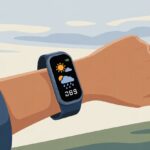Let’s be real—using a fitness tracker on an elliptical sometimes feels like we’re teaching our gadgets a brand new dialect, one awkward step at a time. We want credit for every drop of sweat, but our trackers just blink back at us like, “Jogging? Walking? Sorry, I’m lost.” Still, don’t give up. We can use our fitness trackers on the elliptical by tracking heart rate, time, and picking the closest activity mode—even if it doesn’t actually say “elliptical.”

Let’s shake things up by tweaking settings, adding distance by hand, or even wearing the tracker somewhere less obvious (hello, ankle strap). Apps and extra sensors can also help our trackers get smarter, giving us the stats we really want. So let’s outwit the machines and finally get those calories counted.
Getting to Know Your Fitness Tracker
Honestly, figuring out how our gadgets work with the elliptical can feel almost as tricky as the workout. We need to think about which trackers actually cooperate with ellipticals, which features matter, and how to set everything up without losing our patience.
Compatible Fitness Trackers for Elliptical
Not every tracker is ready for the elliptical adventure. Some just count steps and call it a day. The best options for us include wearables like Fitbit, Garmin, and Apple Watch, which let us log elliptical or cross-trainer workouts right out of the box.
Chest straps like the Polar H7 are perfect if we want a classic heart rate monitor and don’t care about a screen barking orders at us.
Fitbit devices usually have an “Elliptical” activity type, and the Fitbit Community even suggests wearing it on our ankle if our arms stay still. Garmin has built-in activity profiles for ellipticals and syncs with Garmin Connect or Strava. Apple Watch logs elliptical sessions in the Workout app and sends the data to Apple Health.
Here’s a quick look at compatible brands:
| Brand | Elliptical Support | Syncs To |
|---|---|---|
| Fitbit | Yes | Fitbit App |
| Garmin | Yes | Garmin Connect, Strava |
| Apple Watch | Yes | Apple Health |
| Polar H7 | Monitors heart rate | Most fitness apps |
Essential Features to Look For
When we’re shopping (or just browsing), we want trackers with built-in heart rate monitoring, touchscreen controls, and easy activity selection. A solid heart rate monitor—like in Garmin, Apple Watch, or the Polar H7—shows us how hard we’re working.
Touchscreens and simple buttons make it easier to start or end an elliptical session without fumbling around. We also want our tracker to recognize and log elliptical workouts, not just “walking in place.” Compatibility with things like Strava or Google Health makes it simple to review our data and, let’s be honest, brag about our calorie burn.
Setting Up for Success
Once we pick our tracker, we need to set it up (ideally without tossing it across the room). First, check for firmware updates. Then open the companion app—Fitbit App, Garmin Connect, or Apple Health—and add elliptical as a favorite activity.
During the workout, wear the device snugly (but not so tight it leaves marks). On some Fitbits, we can use an ankle strap if our arms aren’t moving. For devices that ask for activity types, pick “elliptical” before starting, or log the data manually later if we forget, as explained for Apple Health.
Turn on syncing so our data shows up when we want to admire or analyze it—or just ignore it until we need a little motivation.
Preparing Your Elliptical and Fitness Tracker
Before we start racking up steps and calories, let’s get our elliptical and tracker working together. When these devices team up, our stats stay accurate and our progress actually means something.
Connecting Your Tracker to Your Elliptical
First, let’s check if the elliptical and our fitness tracker can talk to each other—Bluetooth is usually the magic word. Most modern trackers, like the Fitbit Charge 5, can sync with compatible machines for real-time data. If your elliptical has Bluetooth, just tap a few buttons in the tracker’s app to connect.
Some ellipticals just don’t have Bluetooth. That’s fine. We can still track our workout by choosing the manual elliptical mode on our tracker or logging the activity after we finish. For more help, check this Reddit thread on starting elliptical tracking with Fitbit.
If our tracker doesn’t have a heart rate monitor, we should wear one. This gives us heart rate and calories burned—perfect for showing off our hard work.
Calibrating Devices for Accurate Data
Now that our devices are talking, let’s calibrate. That just means we’re setting things up so the tracker understands what’s happening on the elliptical. Stride length matters most. Every elliptical is different, and so are our legs. Getting stride right helps our tracker count distance and steps without going haywire.
Most trackers let us enter or adjust stride length. We can measure the distance of one pedal cycle, then enter it into the tracker’s app. For more accuracy, the Fitbit Community suggests adjusting stride length and logging elliptical activity manually.
Here’s a quick checklist:
- Double-check Bluetooth
- Set stride length
- Make sure heart rate monitoring is on
- Pick “Elliptical” or similar mode for a timed activity
If we set everything up right, we’ll get heart rate, distance, and more—without any unnecessary drama.
Tracking Your Elliptical Workouts
Using a fitness tracker with an elliptical isn’t rocket science, but a few steps make a big difference. Picking the right activity mode, tracking key health metrics, and letting our gadgets do the heavy lifting means less guessing and more sweating.
Selecting the Right Activity Mode
When we hop on the elliptical, our first move should be picking the right activity type on our tracker. Devices like Garmin, Fitbit, and Apple Watch usually have a specific “Elliptical” or “Cardio” mode.
If our tracker doesn’t have “Elliptical,” look for any timed activity or similar cardio mode. These will track heart rate, calories, and time. With some devices, like Garmin’s Fenix series, we might need to calibrate sensors or add a cadence tracker for super accurate results.
Let’s be honest—ellipticals don’t always count steps like a treadmill. So, focus on total activity, time, and heart rate instead of obsessing over step count.
Monitoring Heart Rate and Other Metrics
Tracking heart rate during any workout matters, especially on the elliptical. Most trackers use a sensor on the back to grab our heart rate. Wearing the watch snug (but not too tight) helps a ton.
Modern trackers also show calories burned, respiratory rate, and sometimes even ECG data if we splurged for the fancy version. Watching these stats can help us stay in the “cardio zone”—that magical place where we burn fat and maybe forget we’re not actually on a spaceship.
For longer sessions, stats like average heart rate and calories burned keep us motivated. Some smartwatches will even cheer us on if we hit a new goal—because who doesn’t want a little encouragement from their wrist?
Using Automatic Exercise Detection
If we tend to forget things (and who doesn’t), most newer Fitbits and Apple Watches have auto detection. This feature notices when we start a workout and prompts us to log it. It usually works for common cardio, including the elliptical.
But here’s the thing: automatic detection sometimes mistakes couch dancing for real exercise. We might need to double-check and make sure it picked the right activity. It’s best to review the alert and log it manually if it guessed wrong.
Some trackers will even guess the start and end times, so we can focus on getting through the workout instead of pressing buttons. That leaves our brain free for more important stuff—like figuring out where we left our water bottle.
Making the Most of Your Data
We can actually learn a lot from our fitness trackers, even if they make us glance at our wrists every 10 seconds like we’re expecting a secret mission. Good workout data helps us get better results and stay on track—at least when our motivation hasn’t vanished.
Analyzing Your Workout Statistics
Let’s talk numbers—and not the boring kind. On the elliptical, we should focus on the basics: heart rate, distance, timed activity, and calories burned. Watching heart rate keeps us in the right “zone” for burning fat or building stamina.
Most trackers show us real-time updates, so we can’t drift into lazy mode without noticing. Calories burned might feel like a love-hate relationship, but seeing that number climb is a nice reward. Distance tracking is a bit trickier on the elliptical, but it’s still helpful for setting goals.
We can use Garmin Connect or Strava to keep these numbers in one place—making it easier to share data and, let’s be honest, brag a little.
Reviewing Progress Over Time
Nothing beats seeing progress. With our fitness tracker apps, we get charts and graphs that make us feel like we’re running our own science project.
We can check past workouts, spot trends, and maybe even see muscles we didn’t know we had. Comparing weekly or monthly stats for distance covered, average heart rate, and calories burned helps us track improvements.
If we join groups on Garmin Connect or follow friends on Strava, we can cheer each other on—or just see if our neighbor is secretly a fitness superhero. Consistent review lets us adjust our workouts and set realistic goals, instead of aiming for “Olympic champion” after one week.
Tips for Optimizing Performance on the Elliptical
When we jump on the elliptical, the little tweaks we make can really change the game. Maybe we’re chasing a calorie burn that rivals swimming laps, or we’re just desperate to escape the treadmill blues. Focusing on the small stuff can turn a boring workout into something way more effective—and honestly, a lot more fun.
Adjusting Resistance for Better Results
Resistance on the elliptical is kind of a love-hate thing, isn’t it? Some days it feels like a challenge, other days it feels like a punishment. But most fitness pros will say bumping up the resistance even a little wakes up our muscles and helps us burn more calories. If we stick with low resistance, sure, it’s easy, but we’re not really building much strength.
Why mess with resistance at all?
- Boosts heart rate: The extra effort gets our heart pumping, almost like a tough bike ride or a stair stepper class.
- Targets more muscles: Our legs, glutes, and core all have to work harder when we’re not just coasting.
- Burns more calories: The struggle pays off, especially if we’re tracking progress and want to see those numbers climb.
Intervals work wonders here. Try switching between higher and lower resistance every few minutes. It keeps our brains engaged and gives us a workout that’s more like a treadmill run or a Peloton ride. Fitness equipment experts point out that using resistance wisely cranks up calorie burn and gets our heart rate up.
Mixing Up Your Cardio Routine
Let’s be real, doing the same elliptical workout every day gets old fast. Our bodies catch on, and suddenly we’re burning fewer calories and losing motivation. Who wants that?
Switching things up keeps things fresh:
- Play with intervals—go faster or slower every couple of minutes.
- Mix in other machines, like the bike or stair stepper, to break up the monotony.
- Try cross-training with swimming, running outside, or even a slow jog that feels almost like walking.
If our fitness tracker lets us, we can play around with different activity settings and compare the stats. It’s kind of cool to see how the elliptical stacks up against a tough treadmill climb or a sweaty spin session.
Changing up the routine helps fight boredom and makes it less likely we’ll bail on our workouts. Fitness pros say our muscles get better results when they don’t know what’s coming next.
Common Problems and Troubleshooting
Sometimes, our fitness trackers and ellipticals just don’t want to cooperate. Bluetooth drops, heart rate glitches—tech can really test our patience.
Dealing With Connectivity Issues
Bluetooth is supposed to make syncing our tracker to the elliptical a breeze. But honestly, sometimes it’s a headache. If our devices won’t pair, we should check if both are actually on and not in sleep mode. Turning Bluetooth off and back on? Weirdly effective.
If that doesn’t work, let’s see if the elliptical even supports our tracker or smartwatch. Not every machine does, unfortunately. Restarting both devices can help them play nice. Updating the app or firmware sometimes fixes stubborn issues. If nothing fixes it, maybe it’s time to call in elliptical repair pros.
Connecting to Apple Health or Google Fit? Make sure permissions are set up right. Logging out and back in can help. And if all else fails, maybe the universe just wants us to take a walk outside.
Addressing Inaccurate Readings
Ever had your tracker report marathon-level calories, but you barely broke a sweat? That’s a red flag. Inaccurate heart rate or ECG readings usually come from loose straps or sweaty wrists. Let’s keep the tracker snug, but not too tight.
Wiping our tracker and skin clean helps a lot, especially after a sweaty workout. Elliptical steps can be tricky for trackers since our arms don’t move like they do when we walk. If the step count or distance looks off, we should check if both the machine and tracker are calibrated right.
Sometimes sensors just act up. Recalibrating or restarting the device often does the trick. If things still look weird, the sensors or control board in the elliptical might be failing, leading to erratic readings.
Honestly, sometimes our gadgets just need a little patience—and maybe a dramatic sigh.
Safety and Best Practices
Mixing fitness trackers and elliptical workouts is great, but safety should always come first. A bit of basic know-how and device care can save us from embarrassing gym moments or broken gear.
Guidelines for Safe Workout Sessions
Let’s not skip the basics. When we step onto the elliptical, putting the pedal at its lowest point helps us avoid any accidental acrobatics. Holding the handles is a must—unless we’re looking to star in a gym blooper reel.
Good posture matters. If we stand up straight and stay centered, our fitness trackers (Fitbit, Garmin, Apple Watch—take your pick) can get more accurate data. Standing on our toes is tempting, but keeping our whole foot down helps prevent cramps.
For anyone just starting out, slow and steady wins the race. Twenty to thirty minutes at a comfortable pace is a solid goal. Beginners should aim for three or four sessions a week, letting those legs recover in between. You’ll find more practical safety tips here.
Periodic Device Maintenance
Let’s be real—our fitness trackers go through a lot every time we work out. After each sweaty session, we wipe down our devices.
Sweat and dust love to sneak into those tiny buttons or sensors, sometimes before we even notice. It’s wild how quickly grime builds up, right?
We make sure to sync our trackers on the regular. That way, our step count actually means something (and yeah, we like to brag a little).
Depending on whether you’ve got an Apple Watch, Garmin, or Fitbit, it’s smart to check for software updates at least once a month. Those updates can drop new features or squash bugs—kind of like a surprise fitness upgrade.
Batteries? They’re tricky. Charging after sessions or just glancing at the power level between workouts saves us from that “oh no, dead battery” moment.
If your band starts feeling loose or, honestly, smells like old gym socks, swap it out or give it a good rinse.
A bit of care helps us—and our wearable tech—keep up with all our fitness adventures.
- Why is my fitness tracker not pairing with Apple Health? Troubleshooting for Technologically Cursed Mortals - December 22, 2025
- Why is my fitness tracker not updating firmware? Tech Tantrums and Update Woes Explained - December 21, 2025
- Why is the Sound Quality on My Bluetooth Headphones Poor? It’s Not Just Bad Music Taste! - December 21, 2025






